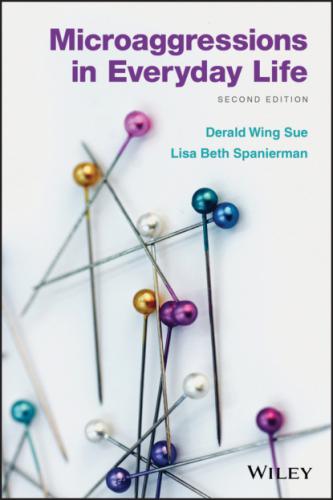Third, many people who privately hold notions of minority inferiority will display their biased attitudes only when they lose control. The opening examples in this chapter, especially that of Rosanne Barr, demonstrate this third condition of losing control. According to Barr, she was taking a sedative, Ambien, which resulted in her being an “idiot.” It is also possible that she was less controlled on this sedative and thus she was unable to censor her racist assumptions.
Microassaults are most similar to “old‐fashioned” racism: They are the type the public generally associates with “true racism”: direct, deliberate, obvious, and explicit. The key to understanding microassaults is that there is no guesswork involved in their intent, which is to harm, humiliate, or degrade people of color, women, and LGBTQ individuals.
At a fraternity sports party, a group of White fraternity brothers were sitting around their living room during a late Sunday afternoon, chugging down beer after beer tapped from a keg. They had just finished watching the first half of a football game and were obviously quite inebriated. Excitedly talking about the last play from scrimmage that resulted in an incomplete pass, one of the guys exclaimed, “Them n*****s can't play quarterback!” This brought out a howl of laughter, and another member said, “That's because they're just jungle bunnies!” More laughter erupted in the room and others produced a flurry of racial slurs: “monkey,” “coon,” “burr head,” “oreo,” and “Uncle Tom!” Each slur brought on laughter and renewed attempts to outdo one another in finding the most degrading reference to Blacks. As they exhausted their list, the game became a form of free association with blackness. “Black pussy, black sheep, criminal, rapist, castration, welfare family, cattle prod,” and so on, they shouted. It was clear that some of those in the group were quite uncomfortable with the game, but said nothing and chuckled at the responses anyway.
(D. W. Sue, 2003, p. 88)
In many respects, members of marginalized groups find it easier to deal with microassaults or blatant racism because the intent is clear and the recipients of such abuse do not have to expend psychological energy on ambiguity. In fact, there are indications that people of color are better prepared to deal with overt microassaults (Salvatore & Shelton, 2007) than unintentional biased behavior that resides outside the level of awareness of perpetrators—microinsults and microinvalidations. Empirical research has supported this assertion, showing that Black and Latinx participants experienced greater cognitive depletion from a confederate's subtle racism compared to overt racism (Murphy, Richeson, Shelton, Rheinschmidt, & Bergsieker, 2012). Thus, subtle, invisible, and unintentional forms of microaggressions are the main subject of this book. Table 2.1 provides examples of common microaggression themes with examples and their hidden demeaning messages directed toward people of color, women, and LGBTQ persons.
Table 2.1 Examples of Racial, Gender, and Sexual‐Orientation Microaggressions
Source: Adapted from D. W. Sue and Capodilupo (2008, pp. 114–117).
| THEMES | MICROAGGRESSION | MESSAGE |
| Alien in One's Own Land Asian Americans and Latinx Americans are assumed to be foreign‐born | “Where are you from?”“Where were you born?” “You speak English very well.” | You are not American. |
| A person asks an Asian American to teach them words in their native language. | You are a foreigner. | |
| Ascription of Intelligence Assigning intelligence to a person of color or woman based on their social‐group identity | “You are a credit to your race.” | People of color are generally not as intelligent as Whites. |
| “Wow! How did you become so good in math?” | It is unusual for a woman to be smart in math. | |
| Asking an Asian person to help with a math or science problem. | All Asians are intelligent and good in math and sciences. | |
| Color‐Blindness Statements that indicate that a White person does not want to acknowledge race | “When I look at you, I don't see color.” | Denying a person of color's racial/ethnic experiences. |
| “America is a melting pot.” | Assimilate/acculturate to dominant culture. | |
| “There is only one race, the human race.” | Denying the individual as a racial/cultural being. | |
| Criminality/Assumption of Criminal Status Person of color is presumed dangerous, criminal, or deviant based on race | A White man or woman clutches their purse or checks their wallet as a Black or Latinx American approaches or passes. | You are a criminal. |
| A store owner follows a customer of color around the store. | You are going to steal/You are poor/You do not belong. | |
| A White person waits to ride the next elevator when a person of color is on it. | You are dangerous. | |
| Use of Sexist/ Heterosexist Language Terms that exclude or degrade women and LGBTQ persons | Use of the pronoun “he” to refer to all people. Checkboxes on a form (male or female to specify one’s gender). | Male experience is universal. Female experience is meaningless. Gender is binary. You must fit into one or the other. |
| An assertive woman is labeled a “bitch.” | Women should be passive. | |
| A heterosexual man who often hangs out with female friends more than male friends is labeled a “faggot.” | Men who act like women are inferior (women are inferior)/gay men are inferior. | |
| Denial of Individual Racism/Sexism/Genderism/Heterosexism Statement that denies one’s personal bias | “I'm not racist. I have several Black friends.” | I am immune to racism because I have friends of color. |
| “As an employer, I always treat men and women equally.” | I am incapable of sexism. | |
| Myth of Meritocracy Statements asserting that race or gender does not play a role in life successes | “I believe the most qualified person should get the job.” |
People of color are given
|
